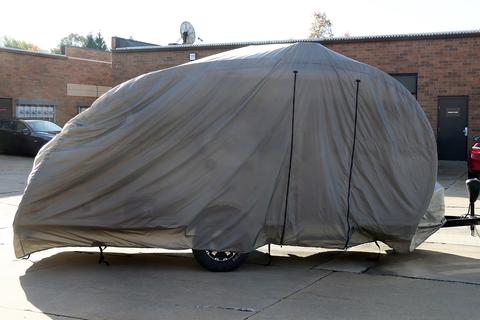What if I were to build a standard foamie/pmf build (with no galley), but after I did my pmf layup I glued a narrow (3”x3” ?) spine of foam down the center of the roof, and then laid a another layer of canvas over the roof? Basically create a “tent” of pmf canvas over the roof.
Why would I do this?
- A pocket of air could be very useful in moderating the temperature. If the air gap wasn’t effective, you could stuff it with insulation.
- I don’t have to worry as much about water intrusion for any holes in my envelope, like ventilation.
- A sloped roof would shed water more effectively, possibly increasing the lifetime of the roof.
- Would be more resilient to hail/rocks/etc. Like wrapping yourself in a trampoline.
- Makes the roof replaceable? I’d imagine you could cut the “Tent” off and put a new one on – you wouldn’t damage the actual structure of the TD.
- Awesome 50’s styling
Why shouldn’t I do this?
- Am I creating a giant snare drum, destined to turn every hail storm into a traumatizing experience?
- Not sure how PMF would perform when not backed by foam, or at the potentially vibrating union of the 2 layers.
- Would the “spine” create a long point load across the center of the roof, causing it to split? Could be mitigated by using an inverted “ T ” of foam down the center to spread the load.
- Would this create a pocket of “dead air” around any ventilation openings? I guess I could just use side vents instead, but then I lose one of the advantages. And it wouldn’t look as cool.
- This might not look cool.
Possible configurations:
- Sealed front and back – no worries about weird aerodynamics, no potential water ingress/mold factory. Couldn’t use air vents under it, maybe creates weird pressure differentials with temperature or elevation, kinda lame.
- Open front and back – I assume airflow helps cooling, air vents may get enough airflow to be passive (wouldn’t want to have to rely on a powered air vent if there’s a potential for dead air), least worry about potential mold factory. Potential weird aerodynamics (Could the front scoop create weird uplift or suck rainwater/roadspray through? Could airflow vibrations at the scoop cause delamination? Would it sound like a vuvuzela going down the highway?).
- Sealed front open back – Less worries about weird aerodynamics, no worries about front edge durability, still able to “breathe”, you could run air vents underneath (probably paired with vents outside the “tent”). Creates large open area I couldn’t access (mold, insects, whatever), potential airflow vibrations causing delamination at back.
- Open front sealed back – Stupid.
I'm really tempted to do this, in the sealed front open back configuration. Can someone explain why this is a terrible idea?
This is might be genius, convince me that I’m an idiot.
Moderator: eaglesdare
8 posts
• Page 1 of 1
Re: This is might be genius, convince me that I’m an idiot.
I got impatient and posted this on r/teardroptrailers last night, and someone suggested doing the tent in fiberglass and/or incorporating some sort of backer board to support the "tent."
Sound like a pretty good idea to me - could help with expansion/contraction, vibration, etc.
Somebody also mentioned using it for storage, which wasn't my original intent but it might be a place to store a couple things for easy access in camp, like a jacket or whatever.
Putting some lights up there could create a cool effect too... or look dorky.
Sound like a pretty good idea to me - could help with expansion/contraction, vibration, etc.
Somebody also mentioned using it for storage, which wasn't my original intent but it might be a place to store a couple things for easy access in camp, like a jacket or whatever.
Putting some lights up there could create a cool effect too... or look dorky.
- t76410d
- Teardrop Inspector
- Posts: 2
- Joined: Thu Sep 09, 2021 2:05 am

